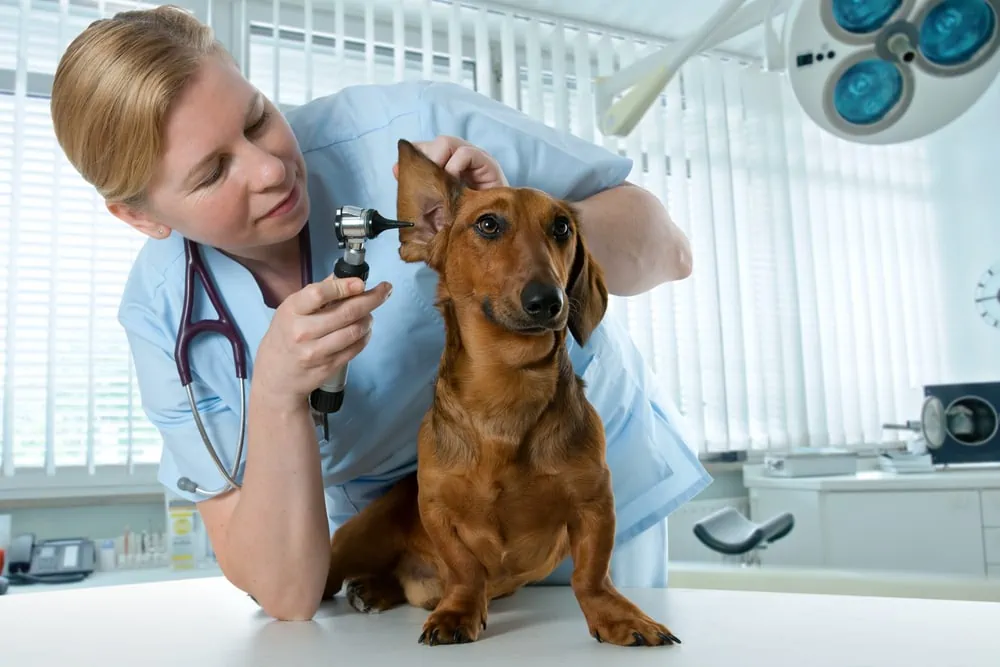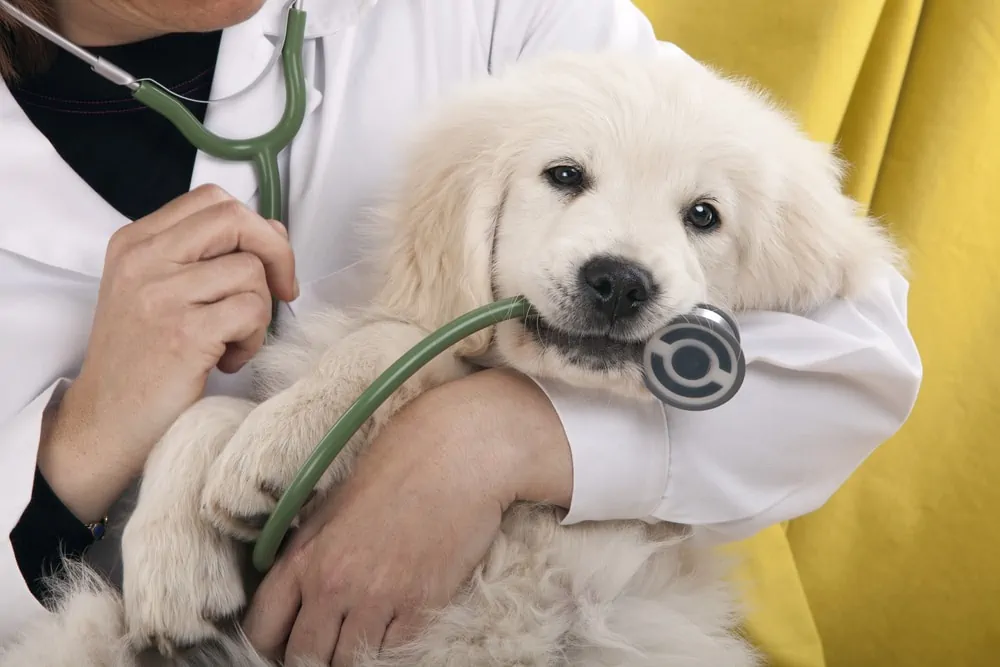Puppies and young dogs are very playful and curious. They climb, jump, and fall daily. Your puppy, like a baby, needs you to protect them from injury.
What should you do if your puppy falls off the couch? If your puppy falls off the couch you should make an assessment of your puppy’s body to check for obvious broken bones. Run your hand over the puppy, paying close attention anytime they whine or cry out. If they have an obvious injury or are not acting like themselves, call the vet immediately.
While cats are very flexible and almost always land on all four paws, dogs are not that flexible and, as a result, are very prone to injury.
Should I let my Puppy on the Couch or Bed?

Whether or not you allow your puppy on the couch or the bed with you is a personal decision.
However, many people prefer to keep their animals off the furniture since small dogs and even larger breeds can also sustain injuries from falling off the couch. There are instances when toy breeds break legs just jumping off the couch.
What about My Deck or Balcony?
Just like a couch or bed, a puppy could easily take a fall off your deck, balcony, or porch. Being curious is one of their most adorable qualities, but it also gets them into trouble.
Puppies are small and can easily fit through tiny spaces such as the space between the slats on a railing.
Some people will use their dog’s leash and tether their puppy to the railing while not considering the fall risk.
Tethering will not prevent your puppy from squeezing between the slats and falling or jumping. The dog could potentially hang themselves before help could arrive.
How to Tell if Your Dog was Injured
If your puppy falls and injures themselves, you may need to make an appointment with the vet. If there are no obvious or severe injuries, you will still want to observe your puppy for a couple of days to see if signs of injury emerge (source).
Over time, your dog may display a reluctance to stand or walk. They may also whimper or cry when lying down or getting back up.
Your puppy may begin to limp or not be able to bend its leg joints, giving them a stiff gait.
If their chest and stomach move more than usual when taking a breath, they flare their nostrils, or are breathing through their mouths but not panting, your dog might be having difficulty breathing.
Whining or barking can be indicative of pain, excitement, or wanting attention. If your dog is whining after a fall, they are telling you it hurts somewhere, and that they need your help. They may also be lethargic, not wanting to play, or even eat.
A lack of appetite or pain when eating could mean an injury to their mouth or jaw. Even senior dogs look forward to dinner and happily scarf their kibble.
Here’s a short video if your dog is limping:
What Kinds of Injuries are Associated with Falling?
Typical injuries from falls include broken bones, broken tails, head trauma or concussion, or soft tissue injuries such as strains and sprains. I have included a section explaining symptoms and treatment for each of these injuries.
Soft Tissue Injuries
There are two types of soft tissue injuries: a strain, which affects the tendons, or a sprain, which affects the ligaments.
A strain happens when the tendons holding the muscle to the bone become stretched too far. The hips and thighs are the most prevalent area in dogs for strains to occur.
A sprain involves the ligaments which join the bones together. The knee and wrist joints of the legs are the most common areas for sprains. The cranial cruciate ligament (CCL), found in the knee, is very critical as this ligament holds the bones of the knee together.
Treatment of strains and sprains is very similar. The vet will assess your dog, looking for signs of swelling, soreness, warmth, and if the joints are out of place.
The vet will next perform X-rays to be sure there are no fractures. To determine if there is a soft tissue injury, your vet will do an MRI or ultrasound because an X-ray will not show ligament or tendon damage (source).
During your dog’s recovery, the vet will advise you to keep your dog calm and walk them using a leash. A very active dog may need to be in a crate and some type of support, such as a brace, may be recommended. The vet will also prescribe pain killers until the dog has recovered.
Broken Bones
While humans have a possible 206 bones to break, dogs have approximately 320 bones to break. The exact amount of bones differs from breed to breed and is related to whether they have a long or short tail.
Car accidents and falls are the most common causes of broken bones, and toy breeds have been known to break bones by falling off a couch.
If your dog appears to have a broken bone, have your dog remain still and run your hands over their body. Feel for any abnormalities such as swelling, bleeding, or limbs in odd positions. The bone may only be dislocated and not broken.
If your dog is bleeding, and the bone is protruding from the wound, tightly wrap a towel around the area to protect it from infection. Use firm but light pressure on the wound to stem the bleeding once it is covered.
Not all cases of broken bones will be immediately apparent. Your dog may get up after the fall and begin playing and behaving normally.
If possible, restrict your dog’s movements for a few days. If they start to limp, hesitate to put weight on a limb, or begin dragging their leg, there may be a fracture.
A fall from a significant height could also result in a spinal injury. If you suspect your dog may have injured or broken their spine, do not let them move.
Restrain them immediately and have someone find a board or old door to help carry your dog to the vet. Even if you have a small dog, you should not carry them in your arms because you could potentially cause further injury to the spine.
Internal Injuries
Internal injuries are not always evident at first and are potentially life-threatening. Fractures and broken bones can puncture organs, such as the spleen, leading to internal bleeding, or the lungs causing difficulty breathing.
Early symptoms of internal injury are very similar to shock and include a rapid heartbeat, shallow breathing, lethargy, black diarrhea, and gum discoloration (pale or blue gums indicate the condition is very serious).
Further signs your dog may have internal injuries include whimpering when touched or moved, vomiting or coughing blood, or having eyes that appear glazed and not focused.
The vet will also look for hernias. A diaphragmatic hernia is a small tear in the abdominal wall that separates the chest from the abdomen.
This leaves a gap for the liver, spleen, and intestines to move into the chest cavity, inhibiting breathing.
Hernias may also occur in the abdominal wall, leaving a pocket that could trap the intestines or bladder. Both are life-threatening conditions.
Broken Tails
A dog’s tail is one of their greatest assets because it is how they “talk” with us. Dogs use the tail for “communication and balance” (source).
The most common tail injury is a fracture. Fractures can occur in several ways, from having their tail stepped on to falling from a very high place. As with the rest of your dog’s body, quickly assess their tail by watching them wag it.
If broken, they will only be able to wag it in one direction and not past the break. If the bone has broken through the skin, there will be lots of blood since a dog’s tail bleeds profusely.
A tail broken at the base requires immediate veterinary care. There could be serious nerve damage endangering your dog’s health that will require surgery.
Head Injuries
If your dog falls from a significant height and lands on their head, they may suffer a concussion, a contusion, bleeding on the brain, or a coup-contrecoup.
Concussions
A concussion is a traumatic brain injury frequently seen in puppies and small dogs because people tend to carry them in their arms or, in the case of toy breeds, dog purses.
While there are many owners who love to cuddle and carry puppies around with them, puppies are wriggly and full of energy, making them very easy to drop.
Contusions, Intracranial Bleeding, and Coup-Contrecoup Injuries
A contusion results from a direct impact to the head causing the brain to bang into the skull. In turn, this causes intracranial bleeding on the surface layer of the brain resulting in a bruise. If the impact is great enough, a coup-contrecoup will occur.
A coup-contrecoup happens when the brain also hits the skull on the opposite side of the head, resulting in contusions on both sides of the brain.
How to Treat Your Puppy for a Head Injury

If your dog loses consciousness, even if they wake seeming fine, bring the dog to the vet as soon as possible.
According to PedMD, “Any type of brain injury should be considered an emergency that requires immediate hospitalization” (source).
Once you have determined your dog may have a concussion or other brain injury from a fall, have them lie down in a cool, calm spot. Look for subtle signs of a concussion, such as a sedated or glazed look in their eyes.
You may also observe their eyes constantly moving forward, backward, and side-to-side, and your dog will not interact with you as they normally would.
Even though a brain injury may not be life-threatening, only your vet can make that determination.
Early intervention allows the vet to give your puppy the very best treatment and, hopefully, keep their condition from worsening.
Transporting a Puppy with a Suspected Brain Injury
How you transport your puppy means everything. You want to prevent further injury and complications.
As with transporting a dog with broken bones, certain safety measures will ensure no further injuries occur. Keep your dog’s head elevated 30 degrees by using a pillow or folded blanket underneath.
Also, remove their collar, even if it is not tight because it could still constrict blood flow to their brain. If your dog can walk, use a harness to keep pressure off the neck area.
With head injuries, time is of the essence. Call the vet and let them know you are on the way with an emergency, giving the vet time to be ready as soon as you arrive.
The sooner the vet begins treating your dog, the greater their chances of a speedy recovery.
Shock
Shock is a life-threatening condition. If not properly treated, major organs will fail to receive the blood and oxygen needed for survival. Your dog may go into shock from the trauma of their injuries.
Signs of shock are similar to signs of internal injury and include pale or bluish gums, irregular heart rate, lowered temperature and slowed mental activity. It is also possible your dog could lose consciousness.
Treating your dog for shock goes hand-in-hand with treating their injury. Your dog needs to be kept warm and calm.
Wrap your dog in a blanket or towel to prevent any loss of body heat, and treat wounds as quickly as possible to prevent too much blood loss.
Loss of Consciousness
If your dog loses consciousness on the way to the vet, do not panic. If you do not see your dog’s chest rising and falling, hear or feel air coming from their nose or mouth, or cannot get a pulse, you will need to perform CPR immediately.
To check for your dog’s pulse, feel behind the back leg where you will find their femoral artery.
Lifesaving CPR for dogs is very similar to performing it on humans. Lay your dog on their side and position your dog’s head up and back, which will open the airway. You will be working behind your dog, and your knees will be by their back, not stomach.
First, check to see if anything is obstructing their airway. Gently open your dog’s mouth and pull the tongue forward. If you see an obstruction, remove it (source).
If your dog does not begin to breathe at this point, cup your hands around their muzzle and gently blow four or five breaths into their nose. You will see their chest rise and fall.
If this fails to revive your dog, you will then begin chest compressions. Place one hand over the other on your dog’s ribs, and pulse for 30 counts. Stop, breathe twice into their nose, and then start thirty more compressions.
Then, stop, breathe twice into their nose, continuing this pattern until your dog is breathing on their own. In an emergency, do not be too afraid to press hard. While you might break your dog’s ribs, you may just save their life.
Once at the Vet

Whether your dog has head trauma, broken bones, or soft tissue injuries, the vet will check your dog’s vital signs.
They will listen to their heart and lungs and monitor the dog’s blood pressure. The vet will also make sure your dog is not dehydrated and is receiving enough oxygen by taking a small amount of blood.
In the event of broken bones or soft tissue injuries such as strains or sprains, the vet will take X-rays. If the X-rays are inconclusive, further tests such as a CT scan, MRI, or ultrasound may be ordered to evaluate tissue and tendons.
X-rays only show bone, whereas a CT scan, MRI, and ultrasound will show the surrounding tissue and tendons.
Your vet may want to admit your puppy for observation, especially in the event of a head injury.
Complications such as brain swelling and bleeding into the brain may not occur immediately. A hospital stay gives the vet time to observe your dog for secondary injuries and give immediate life-saving treatment.
Your dog may need to take medicine for pain or nausea. Do not give them your medications which are meant for human consumption; many of these are toxic for dogs. Any medications you give your dog should come from the vet.
Prevention
We have all heard the saying, “An ounce of prevention is worth a pound of cure.” Taking time to puppy-proof your home is worth not having to make an emergency trip to the vet.
Carpeting under couches and beds will help cushion a fall. If you have hardwood floors and do not want to carpet over them, consider an area rug.
Having grass in their play area or by decks can cushion a fall and lessen its severity.
Gate off stairs until your puppy has mastered climbing up and down, and wrap railings on decks and balconies with netting. Keep a puppy first aid kit in an easily accessible spot.
**Does your Dog’s Feet Turn Outward When Standing? Find out the reason in this guide here!**
Final Thoughts
Puppies are small and curious beings that need special care and attention. Puppies will fall, get scrapes, and sometimes put themselves in precarious positions.
They are just learning to walk, jump, and run and do not always have perfect balance or agility. As they get older, keep the rugs on the floor and the wrap around the railings. Older dogs fall too.
As pet owners, we are not perfect and cannot prevent every accident from happening, so there will be accidents. What we can do is be prepared, remain calm, and, if need be, call the vet.


0 Comments